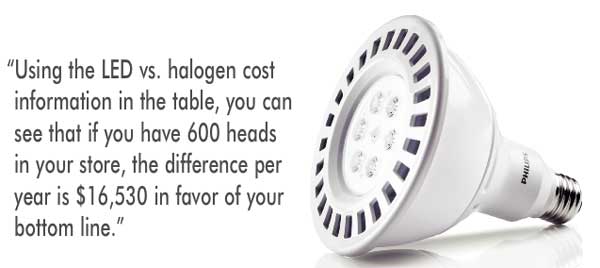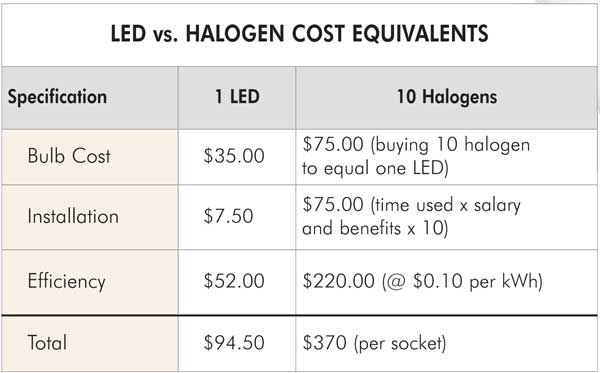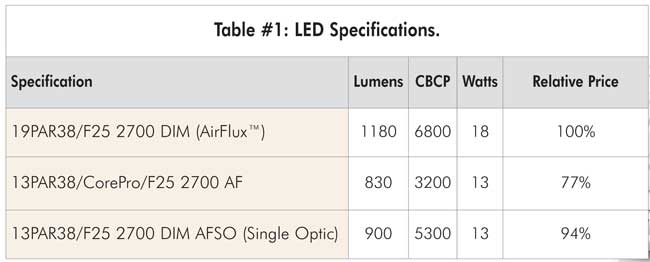Articles on LED accent lighting have ranged from the promise of a “better” way to light retail to the reality of today’s retail lighting. Early adopters saw the promise and even though they knew another product tomorrow might be “better” they took the plunge and relamped their stores. If you haven’t made the move yet, maybe you’ll be interested in where we are today and how the promise came true.
In 2009 I wrote an article, “Path to Sustainable Retail Lighting. LEDs & More” (Furniture World Magazine, October/November 2012) that led to some interesting conversations. At a point in the discussion I would be asked, “Do you like LEDs or not?” because my answer in that article – “sometimes” was pretty vague. Five lighting years later my answer is, “Absolutely yes.”

In 2009 what I called the first generation of LED could replace a 45-50 watt halogen in retail settings. My concern then was that 45-50 watts in track lighting didn’t meet the criteria of sustainable lighting: "Lighting that meets the qualitative needs of the visual environment with the least impact on the physical environment.” My thought was 45-50 watts wasn’t enough light to show the color and textures of our home furnishings products. Today, we have LEDs that can replace a 120-watt halogen, so we can meet both criteria.
Three light years later in “Time For Furniture Store LED's” (Jan/ Feb 2012 Furniture World) I stuck with the “sometimes” endorsement for the second generation bulbs but added, “Personally I would switch from halogen to LED when the third generation, 2700K bulb is available in 2012.” I was caught by surprise when it didn’t look like a space capsule. There were other surprises as well.
Improved led
LED Features & Benefits
The lighting industry has made great progress in LEDs, but I tip my hat to Philips and the “AirFlux™” design. The reason most LEDs look like a space capsule is a heavy heat sink that takes heat away from the electronics inside the bulb. AirFlux™ eliminated the heat sink in favor of passing air over the electronics. It is similar to a jet engine that pulls cool air in the front and exhausts hot air out the back. There are no moving parts, so comparing the process to a chimney will do. The point is that heat is removed from the electronics by air flow, and that is a good thing.
In addition to looking more like a PAR light bulb, the 3rd generation AirFlux™ is much lighter. That means there is likely to be less “head droop” where the weight of the LED causes the track head to lose position. That is really common in older track heads and results in a lot of labor to correct the aim.
The 3rd generation produced about 50 lumens per watt with an 18-watt lamp. Output is roughly equal to a 60-watt halogen and I have seen some nice stores illuminated with 60-watt halogens. Beyond a nice look, the LED is more efficient. The 60-watt halogen only generates 15 lumens per watt so the energy savings of 42 watts per lamp is significant.
Fewer Features & More LED Benefits
Four light years later we have an improved 3rd/4th generation LED. The first improvement in the AirFlux™ design was to eliminate dimming, reduce input watts and increase lumens per watt. Initially, companies like Philips thought that since halogen lamps were dimmable, that this feature was a required feature on replacement LEDs. Dimming is not a requirement for retail display lighting, so taking the dimming circuitry out reduced the price by 23%.
Reducing the input watts of new lamps in the CorePro series further reduced the total cost of ownership. The resulting 13-watt LED PAR lamp generated 58 lumens per watt and was still in the range of a 60-watt halogen. Good but could be better.
Best so far: Gen 4
Some folks didn’t like the gray bodies of the early LED PAR lamps; some did. Some folks didn’t like being able to see individual LEDs on the face of the PAR lamp; some didn’t care. Many lighting manufacturers used a single optic, one lens to focus light from the LEDs into a coherent beam. There was competitive pressure for Philips to offer a single optic but while they were changing things they came up with a significant boost in output.
The “Single Optic” LED from Philips keeps a 13-watt input but boosts output to 69 lumens per watt for a total of 900 lumens. With that output focused into 5300 Center Beam Candle Power (CBCP) the 13PAR38 can compete against 75-90 watt halogens. The 19-watt version is comparable to a 120-watt halogen. With 1,180 lumens and 6,800 CBCP the 19 watt has enough power for the front window.
For sockets that need a PAR30, slightly smaller LED the Retail Optic version drops to 12 watts but still produces 850 lumens and 5,000 CBCP. That is strong enough to compete with anything in a PAR30 size and meets both parts of the sustainable lighting criteria.
Doing the Math On LED's
LED technology has really changed our business as a lighting distributor. In year 2000 we would hear from our customers on a reorder every three to six months. By 2005 that reorder time extended to a year, maybe a little more, because of the service life of the infrared halogen lamps. Making a sale with LEDs basically makes your customer go away because the LED will last for about 10 years. Over the life of the LED you don’t need to reorder or replace the bulbs and that is a major savings.
Another major difference is price. I have an old price list from 1998 showing the price of a halogen at $4.20. That bulb lasted for 2500 hours and today’s halogen version lasts for 4400 hours. By making an allowance for the longer life, today’s halogen costs $4.26 (including freight) which isn’t much change over more than a decade.

Keeping track of LED pricing is like watching the stock market; some days it is up some days it is down. Talking in dollars is really meaningless. The price changes so often so I have used percentages in table #1 to show the "relative" value for each lamp as of March 2014. Take the new 19-Watt Single Optic model. “New” is the operative word and given the lamp's features and benefits it commands a relative price of 100%. The 13-Watt Single Optic has the same features but a lower output. That lamp has a relative price of 94% compared to the Retail Optic. The CorePro series was designed as low cost entry lamps. It does not dim and has a relative price of 77% compared to the best in the line. (See LED Specifications Table).

The other price consideration is that utilities are still offering rebates for using LED display lighting and exit signs. Amounts vary from $10 to $35 and you usually need to apply early in the year when funds are available, but rebates make the conversion a really attractive deal. Here’s the basic math:
Using the LED vs. halogen cost information in the table, you can see that if you have 600 heads in your store, the difference per year is $16,530 in favor of your bottom line. So my clear answer today is, “I like LED lighting.”
Monte Lee is a Regional Manager for Service Lamp Corporation, a distributor of lighting products such as fixtures, bulbs, plus lighting consulting and design services for retailers. Inquiries on any aspect of furniture store lighting can be sent to Monte care of FURNITURE WORLD at mlee@furninfo.com. See all of Monte Lee’s articles on store lighting posted to the Operations Management article archives on the furninfo.com website.